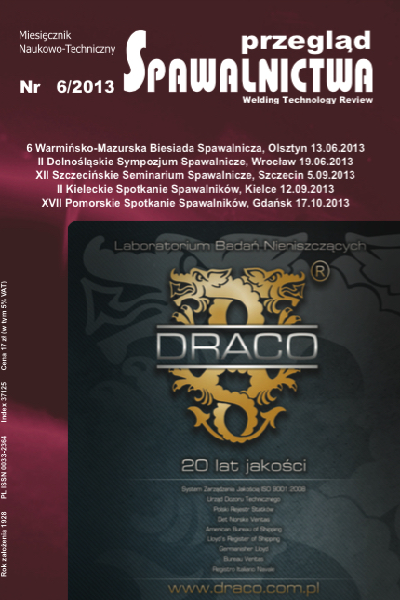Wpływ stereometrii powierzchni na właściwości adhezyjne warstwy naniesionej metodą LPCS
Main Article Content
Abstract
Metoda niskociśnieniowego natryskiwania na zimno (low pressure cold spray LPCS) jest wykorzystywana do wykonywania różnego rodzaju warstw przewodzących, antykorozyjnych, izolujących itp., jak również uzu- pełniania ubytków materiału. Proces może być zautomatyzowany, poprzez podłączenie palnika urządzenia do robota bądź manipulatora, lub też obsługiwany ręcznie, co czyni go bardzo mobilnym. Jednakże automatyzacja jest o tyle korzystna, że umożliwia uzyskanie rów- nomiernie nałożonej warstwy o pożądanej grubości. Ze względu na dużą liczbę współzależnych parametrów, w jednym przejściu palnika można uzyskać ścieg o grubości rzędu od kilkuset mikrometrów do nawet kilku milimetrów. Powstaje wskutek tego warstwa o zróżnicowanej falistości i chropowatości powierzchni. W przedstawionym artykule skupiono się na wyznaczeniu wpływu parametrów procesu LPCS, dających warstwę o określonej falistości oraz chropowatości, przy grubości warstwy do 1 mm. W badaniach wykorzystano proszek aluminium z domieszką korundu, co pozwoliło uzyskać warstwy kompozytowe, które znajdują szerokie zastosowanie jako zabezpieczenie stali przed korozją.
Wpływ stereometrii powierzchni na właściwości adhezyjne warstwy naniesionej metodą LPCS
Abstract
Low Pressure Cold Spray (LPCS) is used to perform various kinds of conductive layers, anticorrosion, insulating, etc., as well as filling the discontinuities in the material surface. The process can be automated by connecting the burner unit to the robot or manipulator and manual, making it extremely mobile. However, the automated system is advantageous in that it allows a uniformly applied layers of a desired thickness. Due to the large number of interdependent parameters in a single burner pass can be seam thickness of the order of several hundred microns to several millimeters - this results in a layer of varying waviness and roughness of the surface. The article focuses on determining the impact of LPCS process parameters on layer having a particular waviness and roughness, and the layer thickness of 1 mm. In the test were used aluminum powder mixed with alumina, allowing for composite layers, which is widely used to protect steel from corrosion.
Downloads
Article Details
Creative Commons CC BY 4.0 https://creativecommons.org/licenses/by/4.0/
Welding Technology Review (WTR) articles are published open access under a CC BY licence (Creative Commons Attribution 4.0 International licence). The CC BY licence is the most open licence available and considered the industry 'gold standard' for open access; it is also preferred by many funders. This licence allows readers to copy and redistribute the material in any medium or format, and to alter, transform, or build upon the material, including for commercial use, providing the original author is credited.
References
Katanoda H., Matsuoka T., Matsuo K.: Experimental Study on Shock Wave Structures in Constant-area Passage of Cold Spray Nozzle, Journal of Thermal Science, vol.16, no.1, 2006, s. 40-45.
Jodoin B., Richer P., Brub G., Ajdelsztajn L., Erdi-Betchi A., Yandouzi M.: Pulsed-Gas Dynamic Spraying: Process analysis, development and selected coating examples, Surface & Coatings Technology, vol. 201, 2007, s. 7544-7551.
Xian-Jin Ning, Quan-Sheng Wang, Zhuang Ma, and Hyung- Jun Kim: Numerical Study of In-flight Particle Parameters in Low-Pressure Cold Spray Process, Journal of Thermal Spray Technology vol. 19, no. 6, 2010, s. 1211-1217.
Schmidt T., Gärtner F., Assadi H., Kreye H.: Development of a generalized parameter window for cold spray deposition, Acta Materialia, vol. 54, 2006, s. 729-742.
Hussain T., McCartney D.G., Shipway P.H., Zhang D.: Bon- ding Mechanisms in Cold Spraying: The Contributions of Me- tallurgical and Mechanical Components, Journal of Thermal Spray Technology, vol. 18, no. 3, 2009, s. 364-379.
Luzin V., Spencer K., Zhang M.-x.: Residual stress and thermo-mechanical properties of cold spray metal coatings, Acta Materialia, vol. 59, 2011, s. 1259-1270.
Goyal R., Walia R. S., Sidhu T. S.: Study of Coating Thickness of Cold Spray Process Using Taguchi Method, Materials and Manufacturing Process, vol. 27, 2012, s. 185-192.
Van Steenkiste T., Smith J.R.: Evaluation of coatings produced via kinetic and cold spray process, Journal of Thermal Spray Technology, vol. 13, no. 2, 2004, s. 274-282.
Lima R. S., Kucuk A. C. C.: Berndt Deposition efficiency, mechanical properties and coating roughness in cold-sprayed titanium, Journal of Materials Science Letters, vol. 21, 2002, 1687-1689.
Balania K., Lahaa T., Agarwala A., Karthikeyanb J. N.: Munroea effect of carrier gases on microstructural and electro- chemical behavior of cold-sprayed 1100 aluminum coating, Surface & Coatings Technology, vol. 195, 2005, s. 272-279.
Wang Q., Birbilis N., Zhang M.-x.: Interfacial structure between particles in an aluminum deposit produced by cold spray, Materials Letters, vol. 65, 2011, s. 1576-1578.
Irissou E., Legoux J.-G., Arsenault B., Moreau Ch.: Investigation of Al-Al2O3 Cold Spray Coating Formation and Properties, Journal of Thermal Spray Technology, vol. 16 (5-6), 2007, s. 661-668.
Shkodkin A., Kashirin A., Klyuev O., Buzdygar T.: Metal Particle Deposition Stimulation by Surface Abrasive Treatment in Gas Dynamic Spraying, Journal of Thermal Spray Technology, vol. 15 (3), 2006, s. 382-386.
Spencer K., Fabijanic D.M., Hang M.-x.: The use of AlAl2O3 cold spray coatings to improve the surface properties of magnesium alloys, Surface & Coatings Technology, vol. 204, 2009, s. 336-344.
Champagne V. K.: The cold spray materials deposition process: Fundamentals and applications, Woodhead Publishing Limited, Cambridge, 2007.
Rech S., Trentin A., Vezzu S., Legoux J.-G., Irissou E. and Guagliano M.: Influence of Pre-Heated Al 6061 Substrate Temperature on the Residual Stresses of Multipass Al Co- atings Deposited by Cold Spray, Journal of Thermal Spray Technology, vol. 20, no. 1-2, 2011, s. 243-251.
